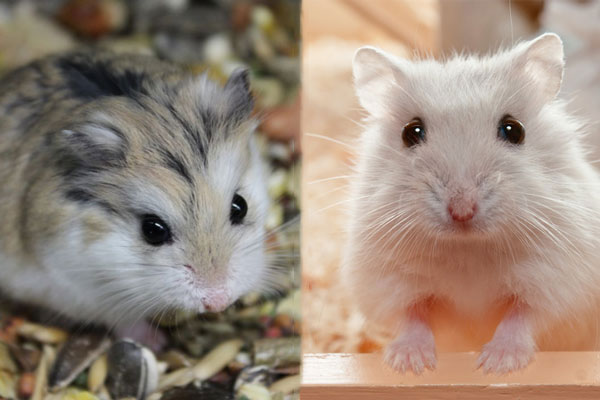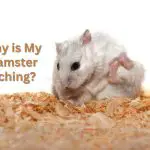Dwarf Hamster vs Hamster: A Comprehensive Comparison
Hamsters are one of the most popular pet choices for their adorable appearance and fun personality. But did you know that there are different types of hamsters, each with its unique characteristics?
So what is there to know about dwarf hamster vs hamster? While both may look similar, there are distinct differences in their size, temperament, lifespan, and care requirements. Dwarf hamsters are smaller, social, and easier to handle, while regular hamsters are bigger, solitary, and can be nippier.
In this comprehensive comparison, we’ll dive into the world of Dwarf Hamsters and Hamsters, and help you determine which one is the right fit for you and your lifestyle. So get ready to explore the fascinating world of hamsters!
Dwarf Hamster vs Hamster: Knowing the Basics
There are many differences between the two species, ranging from their physical characteristics to their behavior, care requirements, and lifespan.

Here is a table comparing the characteristics of Dwarf Hamsters and Hamsters:
| Characteristics | Dwarf Hamster | Hamster |
|---|---|---|
| Size | 4 inches | 6 inches |
| Body Shape | Round and compact | Elongated and cylindrical |
| Fur | Soft and dense | Thick and rough |
| Activity Level | Active during the day | Active at night |
| Social Behaviour | Sociable with other dwarf hamsters | Solitary |
| Aggressiveness | Less aggressive | Can be more aggressive and may bite if threatened |
| Cage Size | Larger cage needed to accommodate activity level | Smaller cage suitable, but needs to provide hiding place and necessities |
| Lifespan | 2-3 years | 1-2 years |
| Suitability | Good for people who want an active, social, and entertaining pet | Good for people who want a low-maintenance, solitary, and nocturnal pet |
Physical Characteristics
As the mane suggests, dwarf hamsters are smaller size in than their counterparts. They typically are about 4 inches long whereas hamsters are 6 inches in length.

The Dwarf Hamsters also have rounder and more compact bodies, whereas regular hamsters have a more elongated and cylindrical shape.
In terms of fur, dwarf hamsters have a soft and dense coat, while hamsters have a thicker and rougher coat.
Behavior
When it comes to behavior, dwarf hamsters are known for being more active during the day and for being sociable with other dwarf hamsters. They are also known for their entertaining antics.

Hamsters, on the other hand, are more active at night and are solitary animals, meaning that they prefer to live alone. They can also be more aggressive than dwarf hamsters and may bite if they feel threatened. However, in nature, a hamster acts differently.
Lifespan
When it comes to lifespan, dwarf hamsters generally live longer than hamsters, living up to 2-3 years on average. Hamsters, on the other hand, have a lifespan of around 2 years.
Overall, when choosing between the two species, you must consider your lifestyle, living arrangements, and what you are looking for in a pet. By taking into account these differences, you can choose the pet that is right for you.
Taking Care: Dwarf vs Hamster
When it comes to taking care of dwarf and regular hamsters, there are some noticeable differences in their needs. Here’s a breakdown of the key points of hamster care:
Dwarf Hamsters
- Housing: These tiny creatures do not need a massive cage; a space of 18 x 12 x 12 inches or larger will do the trick. Consider a multi-level cage setup to add a touch of excitement.
- Bedding: Line the bottom of the cage with a soft bedding material like aspen shavings or CareFresh to provide comfort. Avoid cedar or pine shavings as they can be harmful.
- Diet: As omnivores, dwarf hamsters require a balanced diet of pellets, fresh produce, seeds, and nuts. A constant supply of fresh water should also be available.
- Exercise: Being active creatures, dwarf hamsters love to play. Provide plenty of toys including a wheel, climbing structure, and tunnel to keep them entertained and active.
- Interaction: Social creatures by nature, dwarf hamsters do better in groups. However, it’s crucial to provide each hamster with enough space to have its territory.

Regular Hamsters
- Housing: Being larger, regular hamsters need a cage that is at least 24 x 12 x 12 inches. You should also provide plenty of toys and a multiple-level cage setup.
- Bedding: Line the bottom of the cage with a soft bedding material like aspen shavings or CareFresh to provide comfort while avoiding cedar or pine shavings, as they can be harmful.
- Diet: Regular hamsters, like their dwarf counterparts, are omnivores and require a balanced diet of pellets, fresh produce, seeds, and nuts. Have a constant water supply to the cage.
- Exercise: These active creatures love to play. So provide plenty of toys like a wheel, climbing structure, and tunnel to keep them entertained and active.
- Interaction: Unlike dwarf hamsters, regular hamsters are solitary animals and do their best on their own. If housing more than one, be sure to provide enough space for each hamster to have its territory, as they can become aggressive in cramped spaces.

Here is a summary table of the difference and similarities in taking care of your furry friend for better understanding:
| Category | Dwarf Hamsters | Regular Hamsters |
|---|---|---|
| Housing | A cage that is at least 18 x 12 x 12 inches, small animal habitat with multiple levels | A cage that is at least 24 x 12 x 12 inches, multiple levels and plenty of toys |
| Bedding | Soft bedding material (aspen shavings or CareFresh), avoid cedar or pine shavings | Soft bedding material (aspen shavings or CareFresh), avoid cedar or pine shavings |
| Diet | Balanced diet of pellets, fruits, vegetables, and small amounts of seeds and nuts, fresh water always available | Balanced diet of pellets, fruits, vegetables, and small amounts of seeds and nuts, fresh water always available |
| Exercise | Active and love to play, provide toys (wheel, climbing structure, tunnel) | Active and love to play, provide toys (wheel, climbing structure, tunnel) |
| Interaction | Social animals, do best in groups | Solitary animals, do best on their own |
FAQs
Let’s see some commonly asked questions regarding Dwarf Hamsters and Hamsters.
Q: Can Dwarf Hamsters And Hamsters Live Together?
No, dwarf hamsters are social animals and are often kept in pairs or small groups, while hamsters are solitary animals and should be kept alone. Housing them together can lead to fighting and even death.
Q: Are Dwarf Hamsters More Active Than Hamsters?
Yes. Dwarf hamsters are generally more active than hamsters, and they tend to be more social as well. This can make them better suited for families with children who want to interact with their pets.

Q: Can dwarf hamsters and hamsters be trained?
Yes. Both can be trained to a certain extent. Positive reinforcement techniques, such as giving treats for good behavior, can be effective in training them to perform simple tasks. Such as, coming when called or running in a wheel.
Conclusion
By this comprehensive comparison between Dwarf Hamster vs Hamster, it is clear that both species have special qualities that make them stand out. From their distinct personalities to their different physical features, these hamsters offer something for everyone.
So whether you are looking for a spunky companion or an outgoing friend, there is a hamster out there for you. So why not leap and add one of these adorable creatures to your life today!




